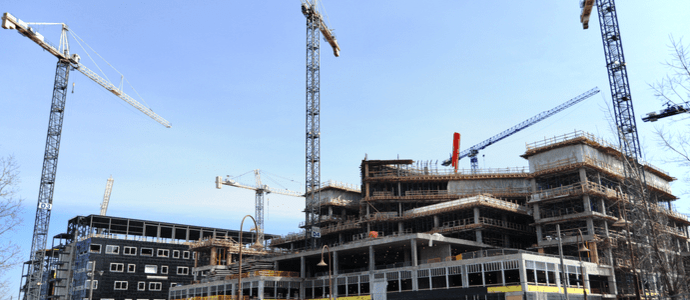The UK’s under-maintenance of public buildings is short-termist and inefficient

Authors: Guy Brett, Dr Connel Bottom, Saurabh Das
The size of the crisis:
The crumbling concrete crisis highlights we defer maintenance at our peril.
Avison Young’s work for government to help find solutions to the lifecycle maintenance blind spot, shines the light on the growing ‘bow wave’ of deferred maintenance from years of fiscal constraints and the staggering levels of underfunding. A week of dramatic headlines brings into focus the seriousness of decades of a ‘sticking plaster’ approach, particularly in schools and hospitals:
• 700,000 pupils learning in a school the DfE believes needs rebuilding or refurbishment
• Over 40% of schools have at least one building where the roof leaks
• Hospitals confining some patients to the ground floor due to load bearing restrictions on upper floors
• Hospitals that use weather forecasts to decide whether a bed can be utilised
• 9 structural supports per bed at one hospital to prevent RAAC induced collapse.
RAAC becomes a problem if water penetrates and corrodes the steel reinforcement within. It requires good manufacture, installation and, above all, maintenance so that roofs don't leak water. Without adequate maintenance funding, building elements eventually fail. When it comes to schools and the public sector estate, this is accompanied by a cocktail of not only safety, but social and economic consequences.
Public sector buildings are a critical part of the UK’s social infrastructure. When they fail, they deprive children of classrooms, patients of operating theatres, prosecutors of courtrooms, passengers of stations, key workers of beds, to name just a few. Unfortunately, the majority of these buildings are over 40 years old, spewing carbon and creating jeopardy from components with a failing life. The list of critically deteriorating assets extends wide and far beyond RAAC panels, for example, windows, roof systems, floor coverings, air conditioning units, boilers, kitchens and cabling.
There is a significant gap between the funding available and Whitehall departments' assessment of what they need to make buildings safe, as reported by the National Audit Office. Our modelling shows the nation's situation is even more serious. We used ‘should cost’ portfolio modelling across the major Whitehall departments to look at what they should be spending, not only to make them safe, but to bring public buildings back into a reasonable state and maintain them at that level.
To put the funding issue into perspective an inadequate £5bn is spent each year to maintain public-sector buildings; however, our portfolio modelling indicates that over the next 20 years approximately £10bn more needs to be spent each year simply to bring up to standard and maintain our vital buildings i.e. £200bn in total.
When budgets are tight, maintenance becomes less of an obvious economic priority and is deferred until it is deemed ‘essential’ or even ‘critical’. Maintenance on schools in the last few years has been less than 25% lower than pre-financial crisis according to the Institute of Fiscal Studies. The longer we defer, the more critical it becomes as building assets deteriorate.
The financial problem is that scrimping on funding today means many more pounds need to be spent in the future. For example, the pooling of water on a poorly maintained flat roof can eventually lead to water ingress. Over time this can penetrate the RAAC panel, corroding the steel and ultimately resulting in a complete rebuild. Our scenario modelling shows that delaying funding on some critical assets can result in a 1.5 times increase in cost over 2 years and a 2 times increase in cost over 4 years.
Where is the fault?
We should refrain from bashing the civil servants. The Office of Government Property in the Cabinet Office has been broadcasting concern over underfunding, issuing guidance across Whitehall and communicating the associated risks for at least 5 years. The property profession across Whitehall has been helping to assess, prepare funding bids and track maintenance requirements. Avison Young provided an industry expert to the Cabinet Office 3 years ago to assist their efforts to secure more funding in the Spending Review for lifecycle maintenance and RAAC remedies. We have also helped officials in the Prison Service to get a handle on the funding they need from the public purse to make prison buildings safe and secure. The officials and professionals make the case for funding but in fiscally challenging times, other priorities and politics are barriers.
Our elected representatives at the Treasury and ultimately Cabinet are the ones who make the difficult calls, balancing political interests with objective evidence. Investment on maintenance is usually not visible. Allocating resources to maintaining our estate does not have the same impact as spending on shiny new buildings and the ‘cutting the ribbon’ moment immortalised in a plaque. Maintenance is easy to axe and get away with in the short term. Arguably it’s the public and voters who need educating to reward a prudent long-term view.
What should be done?
Build greater awareness of the consequences of under-investment - Finance directors and Permanent Secretaries need to be helped to make the case with data-backed evidence of the costs and likelihood of operational disruption e.g. education days lost, cancelled operations, court cases, mental health consultations.
Ensure a viable plan for funding lifecycle renewals and maintenance – long term viability should be a precondition of government investment decisions. In particular, more consideration should be given to the use of sinking funds to set aside money over time to ensure that they have sufficient funds available to meet future lifecycle maintenance obligations.
Improve standards. Codes, regulations, testing, certification and inspection of building materials and products needs to be tightened. While the circumstances of the RAAC crisis and the Grenfell Fire are incomparable, there appears to be a common theme of inadequate inspection, testing and certification of building products.
Research and development. More study is required into proprietary building products and their degradation under different conditions and maintenance regimes.
Rethink Procurement. Commercial arrangements that transfer the risk of design and lifecycle maintenance to the private sector may look expensive, but they incentivise a design, material selection and maintenance regime that ensure that buildings are kept operational over their life. For much of the derision heaped at it, we’d conjecture that unsafe RAAC planks are less of an issue in PFI buildings where maintenance funding is built into the contract.
Review the capability and capacity to manage the public sector estate. With the estates function in departments, agencies and public bodies stripped back after years of efficiency initiatives, the fitness for purpose of the current landscape of responsibilities and oversight of the public estate needs reassessing. The contrast between the speed of response to RAAC issues in the hospital estate contrasts with schools, where the capacity and capability of local authorities and school bodies is fragmented and thinly spread.
Authors: Guy Brett, Dr Connel Bottom, Saurabh Das
Who are we?
Avison Young Strategic Advisory (within PLACE) provides decision support, business case, programme and strategic advice, to governments and corporates, on issues that combine real estate, business operations, corporate finance, place and social value.



